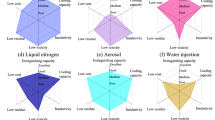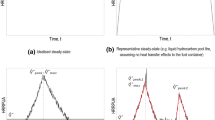Abstract
Historically, methyl ethyl ketone peroxide (MEKPO), a universal hardener in the rubber industries, has caused many serious explosions and fires in Taiwan, Japan, Korea, and China. This study used certain thermal analytical methods to thoroughly explore both why MEKPO led to these accidents and what happened during the upset conditions. Potential process contaminants, such as H2SO4, KOH, and Fe2O3, were deliberately selected to mix with MEKPO in various concentrations. Differential scanning calorimetry (DSC) was employed to calculate the thermokinetic parameters. Kinetic evaluation was also implemented by means of the methods and software developed by Chem-Inform St. Petersburg, Ltd. The results indicate that MEKPO is highly hazardous when mixed with any of the above-mentioned contaminants. Fire and explosion hazards can be effectively lessened if safety parameters and thermokinetic parameters are properly imbedded into manufacturing processes.
Similar content being viewed by others

References
Arpornwichanop, A., Kittisupakorn, P. and Hussain, M. A., “Model-Based Control Strategies for a Chemical Batch Reactor with Exothermic Reactions”,Korean J. Chem. Eng.,19, 221 (2002).
Chang, R. H.,Thermal Runaway Hazard Analysis on Methyl Ethyl Ketone Peroxide with Incompatible Substances, MS Thesis, NYUST, Taiwan, ROC (2003).
Cho, C. K., Chang, K. S. and Cale, T. S., “Thermal Runaway Prevention in Catalytic Packed Bed Reactor by Solid Temperature Measurement and Control”,Korean J. Chem. Eng.,10, 195 (1993).
Chuang, G S., Chao, A. C. and Li, H. Y., “Determination of Multiple Steady States in Oxidation of Monophenols by Tyrosinase with Enzymatic-Enzymatic-Chemical Model”,Korean J. Chem. Eng.,21, 963 (2004).
Chung, T. J., Kim, M. C. and Choi, C. K., “The Temporal Evolution of Thermal Instability in Fluid Layers Isothermally Heated from Below”,Korean J. Chem. Eng.,21, 41 (2004).
Duh, Y. S., Kao, C. S., Hwang, H. H. and Lee, W. L., “Thermal Decomposition Kinetics of Cumene Hydroperoxide”,Trans. Inst. Chem. Eng.,76B, 271 (1998).
Hou, H. Y., Shu, C. M. and Duh, Y. S., “Exothermic Decomposition of Cumene Hydroperoxide at Low Temperature Conditions”,AIChE J.,47(8), 1893 (2001).
Jo, Y. D. and Kim, J. Y., “Explosion Hazard Analysis in Partially Confined Area”,Korean J. Chem. Eng.,18, 292 (2001).
Kang, J. W., Lee, K. H. and Koh, C. I., “The Kinetics of the Sonochemical Process for the Destruction of Aliphatic and Aromatic Hydrocarbons”,Korean J. Chem. Eng.,18, 336 (2001).
Kim, E. H., Kwon, S. W. and Lee, E. H., “A Study on the Photo-reductive Precipitation Rate of Europium Sulfate from Rare Earth Mixture by Addition of Hydrogen Peroxide”,Korean J. Chem. Eng.,19, 305 (2002).
Kim, K. H., Shin, D. and Yoon, E. S., “Risk Analysis Using Automatically Synthesized Robust Accident Scenarios and Consequence Assessment for Chemical Processes: Process Partition and Consequence Analysis Approach”,Korean J. Chem. Eng.,20, 992 (2003).
Kim, K. S. and Ko, J. W., “Real-Time Risk Monitoring System for Chemical Plants”,Korean J. Chem. Eng.,22, 26 (2005).
Kossoy, A. A. and Hofelich, T., “Methodology and Software for Assessing Reactivity Ratings of Chemical Systems”,Pro. Saf. Prog. 22(4), 235 (2003).
Kossoy, A. A. and Akhmetshin, Y,An Advanced Approach to Reactivity Rating, Presented in Inherently Safer Process Designs on Reaction Hazards Workshop., Taiwan, ROC (2005).
Park, K. S. and Kim, J. Y., “Classification and Trend Analysis of Fuel Gas Accidents in Korea between 1996 and 1999”,Korean J. Chem. Eng.,18, 285 (2001).
Moon, S. K. and Sung, W. Y., “Isothermal Interphase Diffusion with Consecutive Reactions”,Korean J. Chem. Eng.,2, 45 (1985).
Shin, C. B. and Choi, C. K., “Thermal Instability in Plane Couette Flow Heated from Below”,Korean J. Chem. Eng.,1, 83 (1984).
Song, H. S., Lee, J. S. and Hyun, J. C., “A Kinetic Model for Polystyrene (PS) Pyrolysis Reaction”,Korean J. Chem. Eng.,19, 949 (2002).
“STARe Software with Solars Operating System”,Operating Instructions, Mettler Toledo, Sweden (1998).
Townsend, D. I. and Tou, J. C., “Thermal Hazard Evaluation by an Accelerating Rate Calorimeter”,Thermochim. Acta,37, 1 (1980).
Won, Y. S., “Non-Isothermal Interphase Diffusion with Consecutive Reactions”,Korean J. Chem. Eng.,3, 1 (1986).
Yu, S. P., Seo, Y. S. and Song, K. S., “Development of a Catalytic Combustor with Heat Exchanger”,Korean J. Chem. Eng.,20, 457 (2003).
Author information
Authors and Affiliations
Corresponding author
Rights and permissions
About this article
Cite this article
Tseng, JM., Shu, CM. & Yu, YC. Thermal hazard simulations for methyl ethyl ketone peroxide induced by contaminants. Korean J. Chem. Eng. 22, 797–802 (2005). https://doi.org/10.1007/BF02705657
Received:
Accepted:
Issue Date:
DOI: https://doi.org/10.1007/BF02705657



